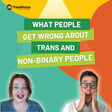
Toilet Talk: Making Washrooms Work for Everyone
Let’s talk about everyone’s favourite topic… toilets! 🚽
This week, Kai is joined by Marni Robinson, Senior Director of Social Impact at HCM Architecture. Over the years, Kai has had the chance to collaborate with Marni and the HCM Architecture team on a number of projects, so this episode is the perfect opportunity to lift the lid (pun intended!) on what it really takes to design facilities that work for everyone.
We wander into the tiled, echoey world of workplace washrooms - From the quiet stress of choosing which door to walk through, to the tiny design details that shape how safe and welcome we feel once we’re inside - this episode explores what it really means to create spaces that work for everyone, trans and non-binary people included.
Whether you’ve never given a second thought to public washrooms or you’re all too familiar with the calculations some of us make just to pee in peace, this conversation will leave you looking at bathrooms in a whole new way.
Take our quizzes and get our free downloadable resources!
1. How Do You Show Up as a Trans Ally at Work? Take our quiz for individuals here
2. How Ready is Your Organization for Trans Inclusion? Take our quiz for organizations here
___________
Want to get in touch? Contact us at podcast@transfocus.ca
Join us on social media:
LinkedIn | Instagram | TikTok | Threads | Facebook



















